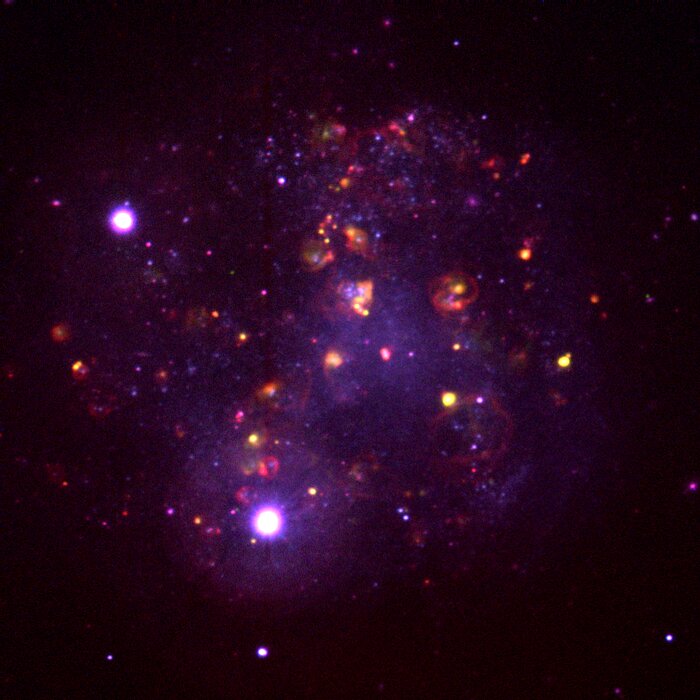The Irregular Spiral IC4182
This unusual image is not a `true color' picture, but a map of emission line regions in the interesting nearby galaxy IC4182. It was made by combining three CCD frames, taken at the Kitt Peak 2.1m telescope in 1992. Every observation used was processed to correct for detector sensitivity variations and to remove regions of detector artefacts caused by manufacturing defects and by the arrival of cosmic rays at the telescope. Two of the monochrome frames that went into this picture were taken through filters that let pass only a narrow range of wavelengths, chosen to reveal something of the physics taking place in the galaxy. The red image was taken in the H-alpha light of excited hydrogen gas, generally associated with young stars and hot dense regions, such as supernova remnants. The green image uses the OIII light of excited oxygen, which we usually find in excited regions of somewhat lower density, such as planetary nebulae. The blue frame is a comparison, taken in what we normally call continuum light, which reveals the general locations of middle-aged, ordinary stars, not bursting with new energy but usually reflecting where most of the mass of the galaxy can be found (hence the similarity between the blue areas of this picture and the `true color' image, also available from the NOAO collection). IC4182 is a relatively nearby galaxy (between 8 and 16 million light-years away, as discussed below) at 13h 03.5m +37d 52m in the constellation Canes Venatici. It is classified as a non-barred spiral with inner structure, but its real claim to fame is its importance in the continuing debate about the overall scale of the Universe. The `holy grail' of studies of the size of the Universe is the `standard candle', whose intrinsic brightness is constant at all locations and all times, so that a simple measurement of apparent brightness would translate directly to a distance. Although no universal standard has been found, a number of astronomical objects appear to provide `standard candles' for restricted distance ranges and types of system, so that our currently constructed distance scale is a `ladder' of complementary approaches. Clearly, it is very important that each `rung' is linked as carefully as possible to its nearest neighbor rungs. Two such rungs are Cepheid variable stars and Type Ia supernovae. Cepheid variables have a well-defined correlation between the rate of their pulsations and their absolute brightness, so that knowing their periods enables us to derive their `candle power'. However, since this technique involves measuring individual stars, it can only be applied to relatively nearby systems. Supernovae, the titanic explosions of stars at the end of their life, come in different varieties, classified partly by their spectra and partly by their light curves (the way their brightness changes with time). The supernovae reliably classified as `Ia' all seem to have the same maximum brightness, which provides a much brighter `standard candle' than do the Cepheid variables. This rung therefore reaches farther out into the cosmos. IC4182 is one of the closest galaxies known to have hosted a type Ia supernova, back in 1937. In addition, IC4182 is in a relatively sparse region of the sky, away from the plane of our Galaxy (the Milky Way), with its confusing nearby bright stars and gas and dust clouds. Such clouds are particularly problematic for `standard candle' studies because they absorb some of the light, and an incorrect allowance for such effects can change derived distances by large amounts. Most importantly, however, IC4182 is close enough to have had a number of its Cepheid variables measured, using the Hubble Space Telescope. Thus, this one galaxy should enable an especially accurate determination of how these two techniques are related. However, this `physics' picture shows a surprising amount of chaotic structure, as well as several large (red) arcs and circles, which are almost certainly the remnants of past supernovae in this galaxy. Unfortunately, as all too often in astronomy, the answer is not uncontroversial. One calculation places IC4182 at the greater end of the range quoted earlier, but also makes the calibration between the two rungs rather different from previous calibrations. Part of the discrepancy is removed by recent measurements indicating that there is somewhat more intervening material than had been believed, but still a stubborn anomaly persisted. Further work recalibrating the original supernova data from 1937 has helped to remove almost all of the discrepancy, pulling IC4182 to the nearer distance. Picture by Mike Pierce and George Jacoby.
Créditos:G.J.Jacoby, M.J.Pierce/NOIRLab/NSF/AURA/
About the Image
| Id: | noao-ic4182n |
| Tipo: | Observation |
| Release date: | 30 de Junio de 2020 a las 21:33 |
| Size: | 1022 x 1022 px |
Sobre el Objeto
Fondos de Pantalla
Colores y Filtros
| Banda | Longitud de Onda | Telescopio |
|---|---|---|
| Optical continuum | KPNO 2.1-meter Telescope Other CCD | |
| Optical OIII | 507 nm | KPNO 2.1-meter Telescope Other CCD |
| Optical Ha | 656 nm | KPNO 2.1-meter Telescope Other CCD |
